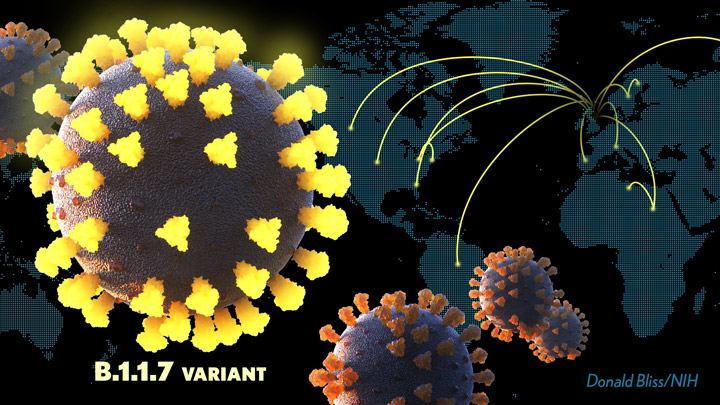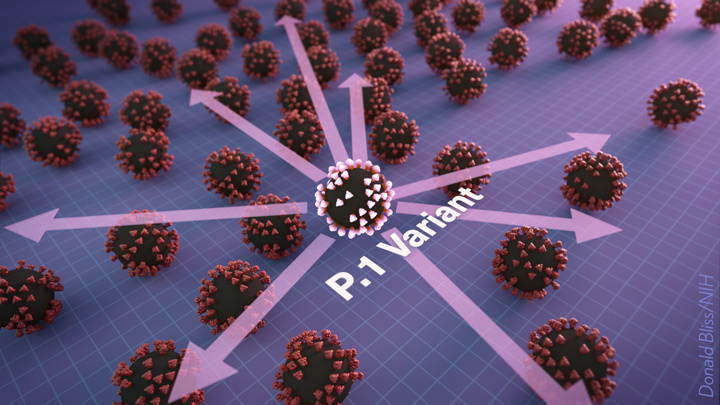P.1
Could a Nasal Spray of Designer Antibodies Help to Beat COVID-19?
Posted on by Dr. Francis Collins

There are now several monoclonal antibodies, identical copies of a therapeutic antibody produced in large numbers, that are authorized for the treatment of COVID-19. But in the ongoing effort to beat this terrible pandemic, there’s plenty of room for continued improvements in treating infections with SARS-CoV-2, the virus that causes COVID-19.
With this in mind, I’m pleased to share progress in the development of a specially engineered therapeutic antibody that could be delivered through a nasal spray. Preclinical studies also suggest it may work even better than existing antibody treatments to fight COVID-19, especially now that new SARS-CoV-2 “variants of concern” have become increasingly prevalent.
These findings come from Zhiqiang An, The University of Texas Health Science Center at Houston, and Pei-Yong Shi, The University of Texas Medical Branch at Galveston, and their colleagues. The NIH-supported team recognized that the monoclonal antibodies currently in use all require time-consuming, intravenous infusion at high doses, which has limited their use. Furthermore, because they are delivered through the bloodstream, they aren’t able to reach directly the primary sites of viral infection in the nasal passages and lungs. With the emergence of new SARS-CoV-2 variants, there’s also growing evidence that some of those therapeutic antibodies are becoming less effective in targeting the virus.
Antibodies come in different types. Immunoglobulin G (IgG) antibodies, for example, are most prevalent in the blood and have the potential to confer sustained immunity. Immunoglobulin A (IgA) antibodies are found in tears, mucus, and other bodily secretions where they protect the body’s moist, inner linings, or mucosal surfaces, of the respiratory and gastrointestinal tracts. Immunoglobulin M (IgM) antibodies are also important for protecting mucosal surfaces and are produced first when fighting an infection.
Though IgA and IgM antibodies differ structurally, both can be administered in an inhaled mist. However, monoclonal antibodies now used to treat COVID-19 are of the IgG type, which must be IV infused.
In the new study, the researchers stitched IgG fragments known for their ability to target SARS-CoV-2 together with those rapidly responding IgM antibodies. They found that this engineered IgM antibody, which they call IgM-14, is more than 230 times better than the IgG antibody that they started with in neutralizing SARS-CoV-2.
Importantly, IgM-14 also does a good job of neutralizing SARS-CoV-2 variants of concern. These include the B.1.1.7 “U.K.” variant (now also called Alpha), the P.1 “Brazilian” variant (called Gamma), and the B.1.351 “South African” variant (called Beta). It also works against 21 other variants carrying alterations in the receptor binding domain (RBD) of the virus’ all-important spike protein. This protein, which allows SARS-CoV-2 to infect human cells, is a prime target for antibodies. Many of these alterations are expected to make the virus more resistant to monoclonal IgG antibodies that are now authorized by the FDA for emergency use.
But would it work to protect against coronavirus infection in a living animal? To find out, the researchers tried it in mice. They squirted a single dose of the IgM-14 antibody into the noses of mice either six hours before exposure to SARS-CoV-2 or six hours after infection with either the P.1 or B.1.351 variants.
In all cases, the antibody delivered in this way worked two days later to reduce dramatically the amount of SARS-CoV-2 in the lungs. That’s important because the amount of virus in the respiratory tracts of infected people is closely linked to severe illness and death due to COVID-19. If the new therapeutic antibody is proven safe and effective in people, it suggests it could become an important tool for reducing the severity of COVID-19, or perhaps even preventing infection altogether.
The researchers already have licensed this new antibody to a biotechnology partner called IGM Biosciences, Mountain View, CA, for further development and future testing in a clinical trial. If all goes well, the hope is that we’ll have a safe and effective nasal spray to serve as an extra line of defense in the fight against COVID-19.
Reference:
[1] Nasal delivery of an IgM offers broad protection from SARS-CoV-2 variants. Ku Z, Xie X, Hinton PR, Liu X, Ye X, Muruato AE, Ng DC, Biswas S, Zou J, Liu Y, Pandya D, Menachery VD, Rahman S, Cao YA, Deng H, Xiong W, Carlin KB, Liu J, Su H, Haanes EJ, Keyt BA, Zhang N, Carroll SF, Shi PY, An Z. Nature. 2021 Jun 3.
Links:
COVID-19 Research (NIH)
Zhiqiang An (The University of Texas Health Science Center at Houston)
Pei-Yong Shi (The University of Texas Medical Branch at Galveston)
IGM Biosciences (Mountain View, CA)
NIH Support: National Institute of Allergy and Infectious Diseases; National Center for Advancing Translational Sciences; National Cancer Institute
Infections with ‘U.K. Variant’ B.1.1.7 Have Greater Risk of Mortality
Posted on by Dr. Francis Collins

Since the genome sequence of SARS-CoV-2, the virus responsible for COVID-19, was first reported in January 2020, thousands of variants have been reported. In the vast majority of cases, these variants, which arise from random genomic changes as SARS-CoV-2 makes copies of itself in an infected person, haven’t raised any alarm among public health officials. But that’s now changed with the emergence of at least three variants carrying mutations that potentially make them even more dangerous.
At the top of this short list is a variant known as B.1.1.7, first detected in the United Kingdom in September 2020. This variant is considerably more contagious than the original virus. It has spread rapidly around the globe and likely accounts already for at least one-third of all cases in the United States [1]. Now comes more troubling news: emerging evidence indicates that infection with this B.1.1.7 variant also comes with an increased risk of severe illness and death [2].
The findings, reported in Nature, come from Nicholas Davies, Karla Diaz-Ordaz, and Ruth Keogh, London School of Hygiene and Tropical Medicine. The London team earlier showed that this new variant is 43 to 90 percent more transmissible than pre-existing variants that had been circulating in England [3]. But in the latest paper, the researchers followed up on conflicting reports about the virulence of B.1.1.7.
They did so with a large British dataset linking more than 2.2 million positive SARS-CoV-2 tests to 17,452 COVID-19 deaths from September 1, 2020, to February 14, 2021. In about half of the cases (accounting for nearly 5,000 deaths), it was possible to discern whether or not the infection had been caused by the B.1.1.7 variant.
Based on this evidence, the researchers calculated the risk of death associated with B.1.1.7 infection. Their estimates suggest that B.1.1.7 infection was associated with 55 percent greater mortality compared to other SARS-CoV-2 variants over this time period.
For a 55- to 69-year-old male, this translates to a 0.9-percent absolute, or personal, risk of death, up from 0.6 percent for the older variants. That means nine in every 1,000 people in this age group who test positive with the B.1.1.7 variant would be expected to die from COVID-19 a month later. For those infected with the original virus, that number would be six.

These findings are in keeping with those of another recent study reported in the British Medical Journal [4]. In that case, researchers at the University of Exeter and the University of Bristol found that the B.1.1.7 variant was associated with a 64 percent greater chance of dying compared to earlier variants. That’s based on an analysis of data from more than 100,000 COVID-19 patients in the U.K. from October 1, 2020, to January 28, 2021.
That this variant comes with increased disease severity and mortality is particularly troubling news, given the highly contagious nature of B.1.1.7. In fact, Davies’ team has concluded that the emergence of new SARS-CoV-2 variants now threaten to slow or even cancel out improvements in COVID-19 treatment that have been made over the last year. These variants include not only B1.1.7, but also B.1.351 originating in South Africa and P.1 from Brazil.
The findings are yet another reminder that, while we’re making truly remarkable progress in the fight against COVID-19 with increasing availability of safe and effective vaccines (more than 45 million Americans are now fully immunized), now is not the time to get complacent. This devastating pandemic isn’t over yet.
The best way to continue the fight against all SARS-CoV-2 variants is for each one of us to do absolutely everything we can to stop their spread. This means that taking the opportunity to get vaccinated as soon as it is offered to you, and continuing to practice those public health measures we summarize as the three Ws: Wear a mask, Watch your distance, Wash your hands often.
References:
[1] US COVID-19 Cases Caused by Variants. Centers for Disease Control and Prevention.
[2] Increased mortality in community-tested cases of SARS-CoV-2 lineage B.1.1.7. Davies NG, Jarvis CI; CMMID COVID-19 Working Group, Edmunds WJ, Jewell NP, Diaz-Ordaz K, Keogh RH. Nature. 2021 Mar 15.
[3] Estimated transmissibility and impact of SARS-CoV-2 lineage B.1.1.7 in England. Davies NG, Abbott S, Barnard RC, Jarvis CI, Kucharski AJ, Munday JD, Pearson CAB, Russell TW, Tully DC, Washburne AD, Wenseleers T, Gimma A, Waites W, Wong KLM, van Zandvoort K, Silverman JD; CMMID COVID-19 Working Group; COVID-19 Genomics UK (COG-UK) Consortium, Diaz-Ordaz K, Keogh R, Eggo RM, Funk S, Jit M, Atkins KE, Edmunds WJ.
Science. 2021 Mar 3:eabg3055.
[4] Risk of mortality in patients infected with SARS-CoV-2 variant of concern 202012/1: matched cohort study. Challen R, Brooks-Pollock E, Read JM, Dyson L, Tsaneva-Atanasova K, Danon L. BMJ. 2021 Mar 9;372:n579.
Links:
COVID-19 Research (NIH)
Nicholas Davies (London School of Hygiene and Tropical Medicine, U.K.)
Ruth Keogh (London School of Hygiene and Tropical Medicine, U.K.)

